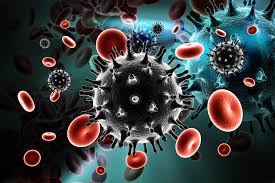
Biohazards are infectious or disease causing agents that can pose a threat to public health or the environment. They can include: bacteria, fungi, viruses, parasites, allergens, cultured cells, etc.
Recombinant DNA (rDNA) is created by combining DNA sequences from separate organisms or portions of a genome that would not normally occur together.
EWU Biosafety Manual. Please refer to this document for information on the procedures, training requirements and regulations governing work with biohazards on the EWU campus.
Biohazard Work in Progress
Anytime a lab is working with biohazardous materials they need to have a door sign alerting people to the hazards. This sign can either be posted continuously or only during times where biohazardous work is in progress.
Topics on this page:
Biosafety Cabinets
Biosafety Cabinets (BSCs) are designed to protect the user, samples, and/or the environment from contamination with biological materials. There are three classes of BSCs (Class I, II, III) which provide increasing levels of protection for the worker, samples, and environment.

Class I BSCs provide protection for the user and environment but not the sample. Samples may be contaminated as air is pulled from the laboratory environment over the sample and funneled through the back of the cabinet. They are suitable for work with low to moderate risk agents.
Class II BSCs protect the user, sample, and environment. They are the primary class of BSC used. This class is divided up into several types based on the amount of air being drawn into the cabinet and how the air is exhausted.
Class III BSCs are used for work with extremely hazardous substances found in Biosafety Level 4 laboratories.
There are two other types of hoods found in laboratories:
Chemical Fume Hoods protect only the user. They are for use with chemical materials and should not be used for biological research. they are designed to pull air away from the user and vent it outside. They would protect the user from potentially infectious materials but would release those materials outside allowing for potential contamination of people as they enter/exit the building. Chemical fume hoods provide no protection for the samples.
Laminar Flow Hoods protect only the material. They blow filtered air over the samples and out towards the user. Because anything in the sample is being pushed out to the user, these must never be used with potentially infectious materials.
Bloodborne Pathogens
Bloodborne Pathogens (BBP) are microorganisms in blood and Other Potentially Infectious Materials (OPIM) that can cause disease in humans.
A few examples of BBP are:
- HIV
- Hepatitis B
- Hepatitis C
- Malaria
- Syphilis

Other potentially infectious materials (OPIM) includes all of the following:
(a) Human body fluids: Semen, vaginal secretions, cerebrospinal fluid, synovial fluid, pleural fluid, pericardial fluid, peritoneal fluid, amniotic fluid, saliva in dental procedures, any body fluid that is visibly contaminated with blood, and all body fluids in situations where it is difficult or impossible to differentiate between body fluids.
(b) Any unfixed tissue or organ (other than intact skin) from a human (living or dead).
(c) HIV-containing cell or tissue cultures, organ cultures, and HIV- or HBV-containing culture medium or other solutions; and blood, organs, or other tissues from experimental animals infected with HIV or HBV.
(d) Blood and tissues of experimental animals infected with bloodborne pathogens.
Occupational Exposure to BBP
Occupational exposure to BBP can occur through laboratory work with blood or OPIM or as a result of job duties. Positions with potential exposure to BBP include (but are not limited to) custodians, grounds keepers, police officers, and people working with sports groups or in sports and recreation.
WAC 296-823 outlines a number of requirements for employees who work with, or have potential exposure to, blood and OPIM. These regulations include:
- Annual BBP training
- Hepatitis B vaccinations through the Occupational Medicine programs
- Exposure Control Plans which outline responsibilities and work practices to reduce the risk of exposure for employees.
Exposure Control Plans
The EWU Exposure Control Plan (ECP) was developed in accordance with WAC 296-823 to cover general work-related exposure to BBP. In addition to the EWU ECP, there is also a Laboratory Exposure Control Plan (LECP) for class or research laboratory work involving blood and OPIM.
Several departments on campus that have a high likelihood of exposure to blood or OPIM have developed department specific Exposure Control Plans. Information found in department specific Exposure Control Plans supersedes information found in the general EWU ECP.
Biosafety Resources
Biosafety in Microbiological and Biomedical Laboratories
Over the past two decades, Biosafety in Microbiological and Biomedical Laboratories (BMBL) has become the code of practice for biosafety—the discipline addressing the safe handling and containment of infectious microorganisms and hazardous biological materials.
NIH Guidelines
The NIH Guidelines for Research Involving Recombinant or Synthetic Nucleic Acid Molecules (NIH Guidelines) detail safety practices and containment procedures for basic and clinical research involving recombinant or synthetic nucleic acid molecules, including the creation and use of organisms and viruses containing recombinant or synthetic nucleic acid molecules.
EWU Biosafety Manual
Please refer to this document for information on the procedures, training requirements and regulations governing work with biohazards on the EWU campus.

